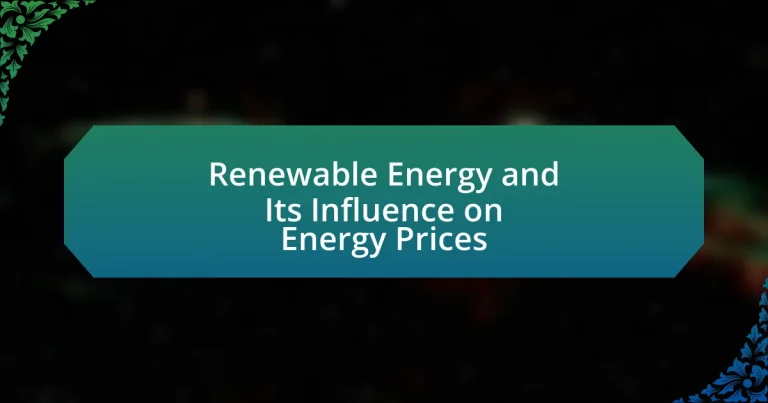Renewable energy, derived from natural sources that replenish quickly, includes solar, wind, hydroelectric, geothermal, and biomass energy. The article examines how the increasing share of renewable energy in the energy mix significantly influences energy prices, often leading to lower costs due to reduced reliance on volatile fossil fuels. It highlights the competitive advantages of renewables, the impact of government policies, consumer demand, and technological advancements on pricing, as well as the challenges faced in integrating these energy sources into existing markets. Additionally, the article discusses the long-term economic implications of renewable energy on job creation and market stability, emphasizing the importance of international cooperation and innovative technologies in shaping future energy landscapes.

What is Renewable Energy and Its Influence on Energy Prices?
Renewable energy refers to energy derived from natural sources that are replenished at a faster rate than they are consumed, such as solar, wind, hydroelectric, and geothermal power. The influence of renewable energy on energy prices is significant; as the share of renewables in the energy mix increases, it often leads to lower overall energy prices due to reduced reliance on fossil fuels, which are subject to price volatility. For instance, the International Renewable Energy Agency reported that the cost of solar photovoltaic (PV) systems has dropped by 82% since 2010, contributing to a decrease in electricity prices in many regions. Additionally, increased competition from renewable sources can drive down prices in energy markets, as seen in countries like Germany and Denmark, where substantial investments in renewables have resulted in lower consumer energy costs.
How does renewable energy impact the overall energy market?
Renewable energy significantly impacts the overall energy market by increasing competition and driving down prices. As more renewable sources, such as solar and wind, are integrated into the energy grid, they contribute to a surplus of energy supply, which typically leads to lower market prices. For instance, in 2020, the International Energy Agency reported that the cost of solar photovoltaic (PV) electricity fell by 89% since 2010, making it one of the cheapest sources of new power generation globally. This price reduction influences traditional fossil fuel markets by forcing them to lower their prices to remain competitive. Additionally, the growth of renewable energy has led to increased investments in energy storage and grid infrastructure, further enhancing market efficiency and reliability.
What are the different types of renewable energy sources?
The different types of renewable energy sources include solar energy, wind energy, hydroelectric energy, geothermal energy, and biomass energy. Solar energy harnesses sunlight through photovoltaic cells or solar thermal systems, while wind energy captures kinetic energy from wind using turbines. Hydroelectric energy generates power from flowing water, typically through dams. Geothermal energy utilizes heat from the Earth’s interior, and biomass energy derives from organic materials, such as plant and animal waste. According to the International Renewable Energy Agency, these sources accounted for approximately 29% of global electricity generation in 2020, highlighting their growing significance in the energy landscape.
How do renewable energy sources compare to fossil fuels in terms of cost?
Renewable energy sources are generally becoming more cost-competitive compared to fossil fuels. According to the International Renewable Energy Agency (IRENA), the cost of solar photovoltaic (PV) and onshore wind energy has decreased by 82% and 49% respectively since 2010, making them among the cheapest sources of new electricity generation. In contrast, fossil fuel prices are subject to volatility and have seen fluctuations due to geopolitical tensions and market dynamics. For instance, the U.S. Energy Information Administration reported that the levelized cost of electricity from natural gas and coal remains higher than that of renewables in many regions, particularly as carbon pricing and environmental regulations become more prevalent. This trend indicates that renewable energy is not only more sustainable but also increasingly more economical than traditional fossil fuels.
Why is the transition to renewable energy important for energy prices?
The transition to renewable energy is important for energy prices because it can lead to lower long-term costs and increased price stability. Renewable energy sources, such as solar and wind, have minimal operational costs once established, as they rely on free natural resources. According to the International Renewable Energy Agency (IRENA), the cost of solar photovoltaic (PV) electricity has dropped by 89% since 2009, making it one of the cheapest sources of new electricity generation. This shift reduces dependence on fossil fuels, which are subject to volatile market prices and geopolitical tensions, thereby stabilizing energy prices over time.
What role does government policy play in renewable energy adoption?
Government policy plays a crucial role in renewable energy adoption by establishing regulations, incentives, and funding mechanisms that promote the development and integration of renewable energy sources. Policies such as tax credits, subsidies, and renewable portfolio standards encourage investment in technologies like solar and wind energy, making them more competitive with fossil fuels. For instance, the Investment Tax Credit (ITC) in the United States has significantly boosted solar energy installations, contributing to a 167% increase in capacity from 2016 to 2020. Additionally, government mandates for renewable energy usage can drive utilities to diversify their energy portfolios, further accelerating the transition to cleaner energy sources.
How does consumer demand for renewable energy affect prices?
Consumer demand for renewable energy typically drives prices down due to increased competition and economies of scale. As more consumers seek renewable energy sources, suppliers are incentivized to invest in and expand their renewable energy offerings, leading to greater supply. For instance, the International Renewable Energy Agency reported that the cost of solar photovoltaic (PV) systems has decreased by 82% since 2010, largely due to rising demand and technological advancements. This trend indicates that as consumer interest grows, the market responds by lowering prices, making renewable energy more accessible.
What challenges does renewable energy face in influencing energy prices?
Renewable energy faces several challenges in influencing energy prices, primarily due to its intermittent nature and the existing infrastructure. The variability of sources like solar and wind leads to inconsistent energy supply, which can create price volatility in energy markets. For instance, during periods of low production, reliance on fossil fuels increases, driving up prices. Additionally, the current energy grid is often not optimized for integrating renewable sources, leading to inefficiencies and higher costs. According to the International Renewable Energy Agency, the transition to renewables requires significant investment in grid modernization and energy storage solutions to stabilize prices and ensure reliability.
How do technological advancements impact renewable energy costs?
Technological advancements significantly reduce renewable energy costs by improving efficiency and lowering production expenses. For instance, the cost of solar photovoltaic (PV) systems has decreased by approximately 89% since 2009, largely due to innovations in manufacturing processes and materials, as reported by the International Renewable Energy Agency (IRENA). Similarly, advancements in wind turbine technology have increased energy output while decreasing installation costs, contributing to a 70% reduction in onshore wind costs since 2009. These improvements not only make renewable energy more competitive with fossil fuels but also enhance the scalability and accessibility of renewable technologies, further driving down costs.
What are the barriers to widespread adoption of renewable energy?
The barriers to widespread adoption of renewable energy include high initial costs, technological limitations, regulatory challenges, and market dynamics. High initial costs deter investment; for instance, the International Renewable Energy Agency reported that upfront costs for solar and wind installations can be significant, despite long-term savings. Technological limitations, such as energy storage and grid integration issues, hinder efficiency and reliability. Regulatory challenges arise from inconsistent policies and lack of incentives, which can create uncertainty for investors. Additionally, market dynamics, including fossil fuel subsidies and established energy infrastructures, create competitive disadvantages for renewable sources. These factors collectively impede the transition to renewable energy systems.

How do Renewable Energy Sources Affect Energy Prices?
Renewable energy sources generally lead to lower energy prices over time due to decreased reliance on fossil fuels and the reduction of operational costs. As renewable technologies, such as solar and wind, become more efficient and widespread, their production costs decline, which contributes to lower market prices for electricity. For instance, the International Renewable Energy Agency reported that the cost of solar photovoltaic electricity fell by 89% between 2009 and 2020, significantly impacting energy prices. Additionally, increased competition from renewable sources can drive down prices in energy markets, as seen in regions where renewables have gained substantial market share.
What are the short-term effects of renewable energy on energy prices?
The short-term effects of renewable energy on energy prices typically lead to a decrease in prices due to increased supply and competition. When renewable energy sources, such as solar and wind, are integrated into the energy market, they often have lower marginal costs compared to fossil fuels. For instance, in regions with high renewable penetration, such as Germany, energy prices have seen reductions during peak production times when renewable generation is high. This phenomenon occurs because the increased availability of low-cost renewable energy can displace more expensive fossil fuel generation, thereby lowering overall market prices.
How do fluctuations in renewable energy production influence market prices?
Fluctuations in renewable energy production significantly influence market prices by altering supply dynamics. When renewable energy generation, such as solar or wind, increases, it typically leads to a surplus in energy supply, which can drive market prices down due to the basic economic principle of supply and demand. For instance, during peak sunlight hours, solar energy production can exceed demand, resulting in negative pricing in some markets, as seen in California’s energy market in 2020, where prices dropped to below zero during high solar generation periods. Conversely, when renewable energy production decreases, such as during low wind or cloudy days, the reduced supply can lead to higher market prices as demand remains constant or increases. This relationship is evident in the volatility of electricity prices in regions with high renewable penetration, where prices can fluctuate dramatically based on real-time production levels.
What seasonal factors affect renewable energy generation and pricing?
Seasonal factors significantly influence renewable energy generation and pricing, primarily through variations in sunlight, wind patterns, and water availability. For instance, solar energy generation peaks during summer months due to longer daylight hours and higher solar irradiance, while it declines in winter when days are shorter. Wind energy generation typically increases in spring and fall when wind speeds are higher, impacting pricing based on supply and demand dynamics. Additionally, hydropower generation is affected by seasonal rainfall and snowmelt, which can lead to fluctuations in water levels and energy output. These seasonal variations directly correlate with market prices; for example, increased generation during peak seasons can lower prices, while reduced output in off-peak seasons can lead to higher prices due to scarcity.
What are the long-term implications of renewable energy on energy prices?
The long-term implications of renewable energy on energy prices generally lead to a decrease in costs. As renewable energy technologies, such as solar and wind, become more efficient and widespread, the overall cost of energy production declines. For instance, the International Renewable Energy Agency reported that the global weighted average cost of electricity from solar photovoltaics fell by 89% between 2009 and 2020, indicating a significant reduction in energy prices associated with increased adoption of renewables. Additionally, as fossil fuel resources deplete and carbon pricing becomes more prevalent, renewable energy sources will likely become more economically favorable, further driving down energy prices in the long term.
How does increased renewable energy capacity impact price stability?
Increased renewable energy capacity enhances price stability by reducing dependence on fossil fuels, which are subject to volatile market fluctuations. As renewable sources like wind and solar become more prevalent, they contribute to a more diversified energy mix, leading to lower overall energy costs. For instance, the International Renewable Energy Agency reported that the global weighted-average cost of electricity from solar photovoltaics fell by 89% between 2009 and 2020, demonstrating how increased capacity can drive down prices. Additionally, renewable energy sources often have zero marginal costs once established, meaning that as their share in the energy market grows, the overall price volatility decreases, stabilizing energy prices for consumers and businesses alike.
What trends are emerging in the relationship between renewable energy and energy prices?
Emerging trends indicate that the increasing adoption of renewable energy sources is leading to a decline in energy prices. As renewable technologies, such as solar and wind, become more cost-effective due to advancements in technology and economies of scale, the overall cost of energy generation decreases. For instance, the International Renewable Energy Agency reported that the global weighted average cost of electricity from solar photovoltaics fell by 89% between 2009 and 2020. This trend is further supported by the growing integration of renewables into energy markets, which enhances competition and drives down prices. Additionally, as more countries commit to renewable energy targets, the shift away from fossil fuels is expected to stabilize and potentially lower energy prices in the long term.

What are the Economic Impacts of Renewable Energy on Energy Prices?
The economic impacts of renewable energy on energy prices generally lead to a decrease in costs over time. As renewable energy sources, such as solar and wind, become more prevalent, they contribute to lower wholesale electricity prices due to their low marginal costs of production. For instance, the International Renewable Energy Agency reported that the global weighted-average levelized cost of electricity from solar photovoltaics fell by 89% between 2009 and 2020, significantly influencing market prices. Additionally, increased competition from renewable sources can drive down prices in traditional energy markets, as seen in regions where renewables have gained substantial market share. This trend not only stabilizes energy prices but also reduces dependence on fossil fuels, further enhancing economic resilience.
How does renewable energy contribute to job creation and economic growth?
Renewable energy contributes to job creation and economic growth by generating employment opportunities in various sectors such as manufacturing, installation, and maintenance of renewable energy technologies. For instance, the U.S. solar industry employed over 250,000 workers in 2019, reflecting a growth rate of 167% since 2010, according to the Solar Foundation’s National Solar Jobs Census. Additionally, investments in renewable energy projects stimulate local economies by creating jobs and increasing demand for goods and services, which can lead to a multiplier effect in the economy. The International Renewable Energy Agency reported that the global renewable energy sector employed 11.5 million people in 2018, indicating a significant contribution to economic growth through job creation and industry expansion.
What industries are most affected by the growth of renewable energy?
The industries most affected by the growth of renewable energy include the fossil fuel industry, utilities, manufacturing, and transportation. The fossil fuel industry faces declining demand as renewable sources like solar and wind become more cost-effective, leading to reduced revenues and job losses. Utilities are adapting their business models to integrate renewable energy sources, which often requires significant investment in infrastructure and technology. The manufacturing sector is impacted as companies shift towards sustainable practices and renewable energy sources for production, influencing supply chains and operational costs. Transportation is also affected as electric vehicles gain popularity, prompting a shift in fuel consumption patterns and infrastructure development for charging stations. These changes are supported by data showing that renewable energy capacity has grown significantly, with global investments reaching over $300 billion in 2020, indicating a clear trend towards a more sustainable energy landscape.
How do energy prices influence consumer behavior and spending?
Energy prices significantly influence consumer behavior and spending by affecting household budgets and purchasing decisions. When energy prices rise, consumers tend to reduce discretionary spending, prioritize essential expenses, and seek energy-efficient alternatives. For instance, a study by the U.S. Energy Information Administration found that a 10% increase in energy prices can lead to a 1.5% decrease in overall consumer spending. This shift often results in increased interest in renewable energy sources, as consumers look for ways to mitigate costs through energy efficiency and sustainable practices.
What strategies can be employed to maximize the benefits of renewable energy on energy prices?
To maximize the benefits of renewable energy on energy prices, implementing a diversified energy portfolio is essential. A diversified portfolio that includes various renewable sources such as solar, wind, and hydroelectric power can stabilize energy prices by reducing dependence on any single source, thus mitigating price volatility. For instance, according to the International Renewable Energy Agency (IRENA), countries that have integrated multiple renewable energy sources have seen a decrease in energy costs by up to 30% over the past decade. Additionally, investing in energy storage technologies enhances the reliability of renewable energy, allowing for better management of supply and demand, which further contributes to price stabilization.
How can consumers take advantage of renewable energy pricing models?
Consumers can take advantage of renewable energy pricing models by opting for time-of-use rates, which offer lower prices during periods of high renewable energy generation. By shifting their energy consumption to these off-peak times, consumers can significantly reduce their electricity bills. For instance, many utility companies provide incentives for using energy during the day when solar power is abundant, leading to potential savings of 20-30% on monthly energy costs. Additionally, consumers can participate in community solar programs, allowing them to benefit from renewable energy without needing to install solar panels on their property, further enhancing their savings and promoting sustainable energy use.
What best practices should policymakers consider to enhance renewable energy’s impact on prices?
Policymakers should implement incentives for renewable energy investments to enhance its impact on prices. By providing tax credits, subsidies, and grants for renewable energy projects, governments can lower the initial costs for developers, leading to increased deployment of renewable technologies. For instance, the U.S. solar investment tax credit has significantly boosted solar installations, contributing to a 90% reduction in solar costs over the past decade. Additionally, establishing renewable energy standards can create a stable market demand, further driving down prices through economies of scale. Research from the International Renewable Energy Agency indicates that global renewable energy capacity has grown by 10% annually, demonstrating the effectiveness of supportive policies in reducing energy prices.
What are the future prospects for renewable energy and energy prices?
The future prospects for renewable energy indicate significant growth, leading to a decrease in energy prices. According to the International Energy Agency (IEA), renewable energy sources, particularly solar and wind, are expected to dominate new power generation capacity, with renewables projected to account for 80% of global electricity demand growth by 2030. This shift is driven by technological advancements, decreasing costs, and supportive government policies. For instance, the cost of solar photovoltaic (PV) systems has dropped by over 80% since 2010, making them increasingly competitive with fossil fuels. As renewable energy becomes more prevalent, the overall energy market is likely to experience lower prices due to reduced reliance on volatile fossil fuel markets.
How might technological innovations shape the future of renewable energy pricing?
Technological innovations will likely reduce the costs of renewable energy production, thereby influencing pricing structures. Advances in solar panel efficiency, such as the development of perovskite solar cells, have shown potential to lower production costs significantly, with estimates suggesting a reduction of up to 50% in manufacturing expenses. Additionally, improvements in energy storage technologies, like lithium-ion batteries, enhance the reliability of renewable sources, making them more competitive against fossil fuels. As these technologies mature and scale, the overall market price for renewable energy is expected to decrease, driven by increased supply and competition. This trend is supported by data from the International Renewable Energy Agency, which reported that the global weighted-average cost of electricity from solar photovoltaics fell by 89% between 2009 and 2020.
What role will international cooperation play in the future of renewable energy markets?
International cooperation will be crucial in shaping the future of renewable energy markets by facilitating technology transfer, investment, and policy alignment among countries. Collaborative efforts, such as the Paris Agreement, demonstrate how nations can work together to set emissions reduction targets and share best practices, which can accelerate the deployment of renewable technologies. For instance, the International Renewable Energy Agency (IRENA) reported that global renewable energy capacity reached 2,799 gigawatts in 2020, largely due to international partnerships that enhance resource sharing and innovation. Such cooperation not only drives down costs through economies of scale but also fosters a more resilient and integrated global energy system, ultimately influencing energy prices positively by increasing supply and competition.




